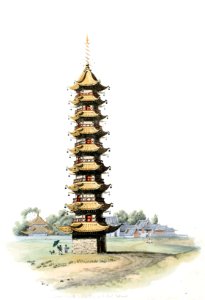Drawing by william alexander, draughtsman of the macartney embassy to china in 1793. A pagoda near the city of sou-tcheou in china. Alexander notes that the chinese name for them is ta, but europeans have improperly denominated them pagodas. Ta's are generally built of brick, and sometimes cased with porcelain, and chiefly consist of nine, though some have only seven or five stories, each having a gallery, which may be entered from the windows, and a projecting roof, covered with tiles of a rich yellow colour, highly glazed, which receive from the sun a splendour equal
to burnished gold. At each angle of the roofs a light bell is suspended, which is rung by the force of the wind, and produces a jingling. The buildings are for the most part octagonal, though some few are hexagonal, and round. They diminish gradually in circumference from the foundation to the summit, and have a staircase within, by which they ascend to the upper story. In height they are generally from a hundred to a hundred and fifty feet, and are situated indiscriminately on eminences or plains, or oftener in cities. Image taken from the costume of china, illustrated in forty-eight coloured engravings, published in london in 1805. Date: circa 1800.
Loading...
